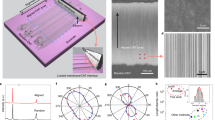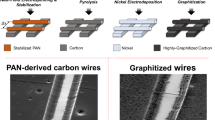Abstract
Many of the applications proposed for nanowires and carbon nanotubes require these components to be organized over large areas with controlled orientation and density. Although progress has been made with directed assembly and Langmuir–Blodgett approaches, it is unclear whether these techniques can be scaled to large wafers and non-rigid substrates. Here, we describe a general and scalable approach for large-area, uniformly aligned and controlled-density nanowire and nanotube films, which involves expanding a bubble from a homogeneous suspension of these materials. The blown-bubble films were transferred to single-crystal wafers of at least 200 mm in diameter, flexible plastics sheets of dimensions of at least 225 × 300 mm2 and highly curved surfaces, and were also suspended across open frames. In addition, electrical measurements show that large arrays of nanowire field-effect transistors can be efficiently fabricated on the wafer scale. Given the potential of blown film extrusion to produce continuous films with widths exceeding 1 m, we believe that our approach could allow the unique properties of nanowires and nanotubes to be exploited in applications requiring large areas and relatively modest device densities.
This is a preview of subscription content, access via your institution
Access options
Subscribe to this journal
Receive 12 print issues and online access
$259.00 per year
only $21.58 per issue
Buy this article
- Purchase on Springer Link
- Instant access to full article PDF
Prices may be subject to local taxes which are calculated during checkout




Similar content being viewed by others
References
Lieber, C. M. Nanoscale science and technology: building a big future from small things. MRS Bull. 28, 486–491 (2003).
McEuen, P. L. Single-wall carbon nanotubes. Phys. World 13, 31–36 (June 2000).
Avouris, P. Molecular electronics with carbon nanotubes. Acc. Chem. Res. 35, 1026–1034 (2002).
Smith, P. A., Nordquist, C. D., Jackson, T. N. & Mayer, T. S. Electric-field assisted assembly and alignment of metallic nanowires. Appl. Phys. Lett. 77, 1399–1401 (2000).
Huang, Y., Duan, X., Wei, Q. & Lieber, C. M. Directed assembly of one-dimensional nanostructures into functional networks. Science 291, 630–633 (2001).
Auvray, S. et al. Chemical optimization of self-assembled carbon nanotube transistors. Nano Lett. 5, 451–455 (2005).
Keren, K., Berman, R. S., Buchstab, E., Sivan, U. & Braun, E. DNA-templated carbon nanotube field-effect transistor. Science 302, 1380–1382 (2003).
Jin, S. et al. Scalable interconnection and integration of nanowire devices without registration. Nano Lett. 4, 915–919 (2004).
Briston, J. H. Plastics Films 71–86 (Longman Scientific & Technical, UK, 1989).
Quanbeck, J. Plastics Machinery & Auxiliaries 18 (May/June 2004).
Cantor, K. Blown Film Extrusion: An Introduction. (Hanser Gardner Publications, Cincinnati, 2006).
Cui, Y., Zhong, Z., Wang, D., Wang, W. U. & Lieber, C. M. High performance silicon nanowire field effect transistors. Nano Lett. 3, 149–152 (2003).
Lin, M. Y. et al. Shear-induced behavior in a solution of cylindrical micelles. Phys. Rev. E 53, R4302–R4305 (1996).
Hobbie, E. K., Wang, H., Kim, H., Lin-Gibson, S. & Grulke, E. A. Orientation of carbon nanotubes in a sheared polymer melt. Phys. Fluids 15, 1196–1202 (2003).
Kim, S. & Karrila, S. J. Microhydrodynamics: Principles and Selected Applications, 1st edn, 76–128 (Butterworth–Heinemann, Boston, 1991).
Cui, Y., Duan, X., Huang, Y. & Lieber, C. M. Nanowires and Nanobelts (ed. Wang, Z. L.) 3–68 (Kluwer Academic/Plenum Publishers, Netherlands, 2003).
Chen, J. et al. Dissolution of full-length single-walled carbon nanotubes. J. Phys. Chem. B 105, 2525–2528 (2001).
Bruinsma, R., Gelbart, W. M. & Ben-Shaul, A. Flow-induced gelation of living (micellar) polymers. J. Chem. Phys. 96, 7710–7727 (1992).
Kilbride, B. E. et al. Experimental observation of scaling laws for alternating current and direct current conductivity in polymer–carbon nanotube composite thin films. J. Appl. Phys. 92, 4024–4030 (2002).
Ounaies, Z., Park, C., Wise, K. E., Siochi, E. J. & Harrison, J. S. Electrical properties of single wall carbon nanotube reinforced polyimide composites. Composites Sci. Technol. 63, 1637–1646 (2003).
Park, C. et al. Dispersion of single wall carbon nanotubes by in situ polymerization under sonication. Chem. Phys. Lett. 364, 303–308 (2002).
Xiang, J. et al. Ge/Si nanowire heterostructures as high-performance field-effect transistors. Nature 441, 489–493 (2006).
Patolsky, F., Timko, B. P., Zheng, G. & Lieber, C. M. Nanowire-based nanoelectronic devices in the life sciences. MRS Bull. 32, 142–149 (2007).
Ahn, J. et al. Heterogeneous three-dimensional electronics by use of printed semiconductor nanomaterials. Science 314, 1754–1757 (2006).
Javey, A., Nam, S. W., Friedman, R. S., Yan, H. & Lieber, C. M. Layer-by-layer assembly of nanowires for three-dimensional, multifunctional electronics. Nano Lett. 7, 773–777 (2007).
Andrews, R. et al. Continuous production of aligned carbon nanotubes: a step closer to commercial realization. Chem. Phys. Lett. 303, 467–474 (1999).
Acknowledgements
We thank M. Ghasemi-Nejhad and R.H. Knapp for helpful discussions. A.C. acknowledges start-up funding from Department of Mechanical Engineering and College of Engineering of University of Hawaii; C.M.L. acknowledges support of this work by Air Force Office of Scientific Research and Defense Advanced Research Projects Agency.
Author information
Authors and Affiliations
Contributions
G.Y. and A.C. performed the experiments. G.Y., A.C. and C.M.L. designed the experiments, discussed the interpretation of results and co-wrote the paper.
Corresponding authors
Ethics declarations
Competing interests
The authors declare no competing financial interests.
Supplementary information
Supplementary Information
Supplementary methods and supplementary figures S1–S4 (PDF 1656 kb)
Rights and permissions
About this article
Cite this article
Yu, G., Cao, A. & Lieber, C. Large-area blown bubble films of aligned nanowires and carbon nanotubes. Nature Nanotech 2, 372–377 (2007). https://doi.org/10.1038/nnano.2007.150
Received:
Accepted:
Published:
Issue Date:
DOI: https://doi.org/10.1038/nnano.2007.150
This article is cited by
-
Toward monolithic growth integration of nanowire electronics in 3D architecture: a review
Science China Information Sciences (2023)
-
Soft-lock drawing of super-aligned carbon nanotube bundles for nanometre electrical contacts
Nature Nanotechnology (2022)
-
Ultra-thin broadband solar absorber based on stadium-shaped silicon nanowire arrays
Frontiers of Optoelectronics (2022)
-
Insights into the generation of laser-induced assembly of MoSe2 nanospheres
Nano Research (2022)
-
Dielectrophoretic Assembly of Carbon Nanotube Chains in Aqueous Solution
Advanced Fiber Materials (2021)



